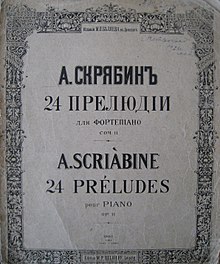24 Preludes op.11 (Scriabin)
The 24 Preludes op. 11 form a piano cycle by Alexander Nikolajewitsch Skrjabin . They were created between 1888 and 1896.
Emergence
One of the 24 Preludes op. 11 (No. 4 in E minor) was written as early as 1888 when Alexander Scriabin was a good 16 years old. In January of this year he entered the Moscow Conservatory and before finishing his work he received his diploma as a “free musician” and a gold medal for playing the piano. Due to severe inflammation in the hand, he went on recreational trips to Berlin, Dresden, Heidelberg, Vitznau, Genoa, Nice and other cities in 1895. It was there that many of the pieces from Op. 11 were written.
construction
The 24 Preludes are written in all major and minor keys and arranged in ascending order in the circle of fifths, as are the 24 Preludes Op. 28 by Frédéric Chopin , which in this respect were a model for Scriabin.
The fact that all major and minor keys appear exactly once in Scriabin's op. 11 is thanks to his publisher Mitrofan Petrovich Belyayev , who put Scriabin under financial pressure to achieve this. Scriabin, however, did not comply with Belyayev's request to write another such volume. Instead of another 24 preludes in different keys, he wrote only 23 (opp. 13, 15, 16 and 17), some of which are in the same key.
The 24 pieces in the collection have the following performance designations (keys in brackets): No. 1 (C major) Vivace - No. 2 (A minor) Allegretto - No. 3 (G major) Vivo - No. 4 (e- Minor) Lento - No. 5 (D major) Andante cantabile - No. 6 (B minor) Allegro - No. 7 (A major) Allegro assai - No. 8 (F sharp minor) Allegro agitato - No. 9 (E major) Andantino - No. 10 (C sharp minor) Andante - No. 11 (B major) Allegro assai - No. 12 (G sharp minor) Andante - No. 13 (G flat major) Lento No. 14 (E flat minor) Presto - No. 15 (D flat major) Lento - No. 16 (B flat minor) Misterioso - No. 17 (A flat major) Allegretto - No. 18 (F minor) Allegro agitato - No. 19 (E flat major) Affettuoso - No. 20 (C minor) Appassionato - No. 21 (B flat major) Andante - No. 22 (G minor) Lento - No. 23 (F major) Vivo - No. 24 (D minor) Presto
Prelude in E major op.11 No. 9
In op. 11 the "central harmonic, melodic and rhythmic achievements of his early compositional development [...] are united like in a burning glass" . In the following, some of these features are enumerated and documented using the slow, cantabellar Prelude in E major:
- It is often chromaticism included,
- z. B. Bars 7–9 in the bass.
- Scriabin is known for layering quarters , i.e. the stacking of fourths to form chords,
- z. B. Measure 4 (first quarter right hand).
- Tone colors are generated by dissonances ,
- z. B. Measure 3, 5, 11, 16 (third quarter right hand).
- The tempo is very free. The piece is characterized by accelerandi , ritardandi and fermatas .
Audio samples
- Prelude Op. 11 no. 9 in E major Andantino
- Prelude Op. 11 no. 10 in C sharp minor Andante
- Prelude Op. 11 no. 13 in G flat major Lento
literature
- Alexandr N. Scriabin: 24 Préludes op.11 for piano , G. Henle Verlag, Munich, ISMN 979-0-2018-0484-2 (search in the DNB portal)
- Sigfried Schibli: Alexander Scriabin and his music: Transgressions of boundaries of a Promethean spirit . Books on Demand GmbH, Nordstedt, ISBN 3-8334-3138-5
Individual evidence
- ↑ Schibli, p. 65, paragraph 2
Web links
- 24 Preludes op. 11 : Sheet music and audio files in the International Music Score Library Project
- Scriabin catalog raisonné at russisches-musikarchiv.de, as of September 28, 2008


